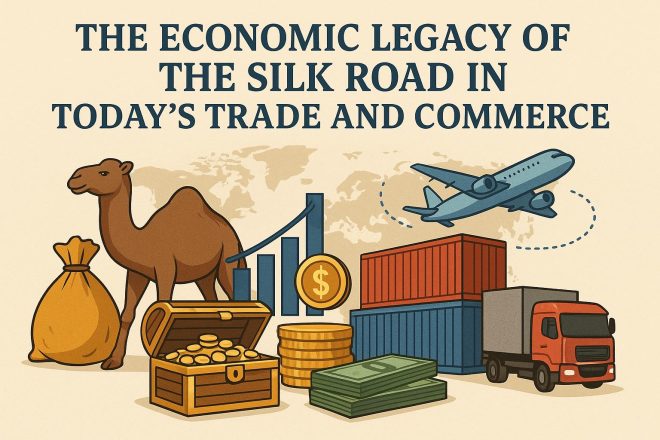The Historical Influence of the Silk Road
The Silk Road, a network of trade routes connecting East and West, played a pivotal role in economic and cultural exchanges spanning over a millennium. Beyond merely facilitating trade between regions, this ancient network served as a crucial conduit for the diffusion of goods, ideas, and cultures. The legacy of the Silk Road is evident even in today’s interconnected economic landscapes, influencing trade, communication, and globalization.
The Silk Road’s Role in Economic Exchange
The Silk Road was a vibrant artery of commerce, bridging continents and invigorating societies with a spectrum of goods, from silk and spices to precious metals and textiles. Merchant caravans traversed deserts and mountains, fostering interactions that transcended simple economic transactions, resulting in a rich tapestry of cultural exchanges. These transactions cultivated a cross-pollination of ideas and innovations that have long-lasting implications, significantly enriching the cultural fabric of the civilizations involved.
Spread of Innovations
Beyond goods, the Silk Road was vital in propagating technological advancements and new techniques across regions. Key innovations such as papermaking, the printing press, gunpowder, and the compass found their way through the Silk Road, gradually transforming societies from Europe to Asia. These technologies propelled scientific and societal advancements, shaping the regions’ developmental trajectories and laying the groundwork for modern technology. The blending of knowledge from diverse cultures accelerated progress, contributing significantly to the global technological landscape we recognize today.
Exchange of Scientific Knowledge
In addition to technological advancements, the Silk Road facilitated the exchange of scientific knowledge. Scholars, philosophers, and physicians traveled along these routes, spreading medical practices, mathematical theories, and astronomical insights. The convergence of Hellenistic, Indian, Persian, and Chinese knowledge along the Silk Road sparked intellectual revolutions that nurtured intellectual growth. A pivotal exchange of medicinal and medical techniques enriched European and Asian practices, enhancing public health and contributing to the advancement of medical sciences.
Modern Economic Parallels
Today, global trade networks reflect the Silk Road’s historical influence, evolving into sophisticated systems of exchange. Modern trade agreements and practices often echo the Silk Road’s philosophy—not solely emphasizing commerce but also nurturing mutual understanding and cultural exchange. The underlying principle remains to bridge societies, cultures, and economies in a coherent global framework.
Globalization and Free Trade
Modern globalization owes much to the Silk Road’s legacy, which fostered interconnectedness across diverse regions. Today, global trade organizations, collaborative efforts, and economic partnerships work to foster environments where goods, services, and ideas circulate freely, just as they did along the ancient routes. Free trade agreements between nations echo the Silk Road’s essence by bringing diverse economies into a shared space, promoting economic integration and collective prosperity.
Infrastructure and Development
Infrastructure development is a cornerstone of modern economic growth, drawing inspiration from the Silk Road’s historical framework. Initiatives such as the Belt and Road Initiative (BRI) mirror the ancient route’s spirit by enhancing international connectivity and logistics. These projects aim to develop strategic infrastructure linking continents, fostering seamless trade, and enhancing regional cooperation. The modern emphasis on infrastructure signifies an enduring appreciation for connectivity, a principle deeply embedded within the Silk Road’s historical significance.
Cultural Exchange Reimagined
As in the past, cultural exchange remains a key component of modern global trade. Global networks not only facilitate economic exchanges but also encourage cultural dialogue and understanding. Through arts, education, and media, diverse societies find common ground, enriching cultural landscapes on a global scale. This cultural interchange fosters peace and cooperation among nations, promoting inclusivity and diversity akin to the cultural exchanges witnessed along the Silk Road.
The Silk Road’s Philosophical Underpinnings
The Silk Road was not just a physical construct of routes and caravans; it embodied a philosophical ethos of connectivity and collaboration. This enduring philosophy still holds relevance in contemporary trade practices and international relations, promoting the notion of trade not merely as an economic necessity but as a vital cultural and technological bridge between societies. The spirit of the Silk Road—integration, collaboration, and the free flow of ideas—continues to shape global interactions, emphasizing the importance of diversity and coexistence.
Conclusion
Though the original Silk Road no longer exists in its historical form, its profound impact on trade and commerce is lasting and undeniable. The historical interactions facilitated across its routes laid the groundwork for modern globalization, demonstrating that trade is more than an economic imperative; it serves as a crucial bridge fostering cultural and technological collaboration. As we progress further into the 21st century, the enduring principles exemplified by the Silk Road continue to influence contemporary trade practices and international relations, underpinning the globalized world we navigate today. These intricate pathways, woven across history, illuminate the timeless potential of trade as a catalyst for interconnectedness and mutual enrichment.
